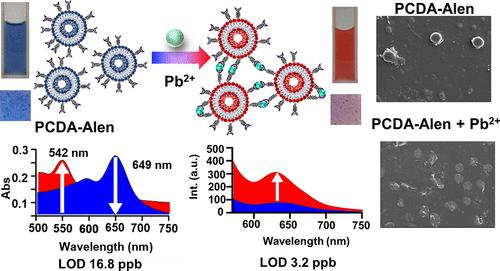当前位置:
X-MOL 学术
›
ACS Appl. Polym. Mater.
›
论文详情
Our official English website, www.x-mol.net, welcomes your
feedback! (Note: you will need to create a separate account there.)
Alendronate-Modified Polydiacetylene (PDA) Dual-Mode Sensor for the Selective Detection of Lead(II) Ions up to the nM Level in Solutions and Agarose Films
ACS Applied Polymer Materials ( IF 4.4 ) Pub Date : 2023-12-30 , DOI: 10.1021/acsapm.3c02670 Ankit Thakuri 1 , Raghunath Acharya 2, 3 , Mainak Banerjee 1 , Amrita Chatterjee 1
ACS Applied Polymer Materials ( IF 4.4 ) Pub Date : 2023-12-30 , DOI: 10.1021/acsapm.3c02670 Ankit Thakuri 1 , Raghunath Acharya 2, 3 , Mainak Banerjee 1 , Amrita Chatterjee 1
Affiliation

|
Lead contamination in humans has been linked to several health risks, such as anemia, cardiovascular problems, renal failure, and irreversible neurological damage. This necessitates the development of efficient sensing tools for low-level detection of lead contamination in water. In this study, we report the design and development of polydiacetylenes (PDAs)-based highly sensitive dual-output sensor for the detection of lead ions in solution and solid phase. Specifically, 10,12-pentacosadiynic acid (PCDA)-derived vesicles were surface modified with alendronate units (PCDA-Alen) to enable specific recognition of lead ions in the presence of other metal ions and possible interfering species. Upon UV irradiation (254 nm), PCDA-Alen displayed a characteristic blue color that, on interaction with lead ions, exhibited a characteristic color transition from blue to red accompanied by a gradual increase in fluorescence emission at λmax 642 nm. PCDA-Alen was indifferent to a variety of cations or anions and displayed detection limits of 16.8 and 3.1 ppb toward lead in UV–vis and fluorescence spectroscopy, respectively, and thus acts as a dual-output sensor. The real sample studies by spiking Pb2+ in samples collected from various natural water bodies demonstrated excellent recovery. PCDA-Alen vesicles immobilized on agarose matrix enabled naked-eye detection of lead ions above 0.5 μM in the solid phase, showcasing exceptional lab-on-film-based detection capabilities, thereby expanding their potential for real-world applications in the detection of lead ions in environmental and biological samples.
中文翻译:

阿仑膦酸盐改性聚二乙炔 (PDA) 双模式传感器,用于选择性检测溶液和琼脂糖膜中高达 nM 级的铅 (II) 离子
人类铅污染与多种健康风险有关,例如贫血、心血管问题、肾衰竭和不可逆的神经损伤。这就需要开发高效的传感工具来低水平检测水中的铅污染。在这项研究中,我们报告了基于聚二乙炔(PDA)的高灵敏度双输出传感器的设计和开发,用于检测溶液和固相中的铅离子。具体来说,10,12-二十二炔酸 (PCDA) 衍生的囊泡经过阿仑膦酸盐单元 ( PCDA-Alen )表面修饰,以便在存在其他金属离子和可能的干扰物质的情况下能够特异性识别铅离子。在 UV 照射 (254 nm) 下,PCDA-Alen显示出特有的蓝色,在与铅离子相互作用时,显示出从蓝色到红色的特有颜色转变,同时在 λ max 642 nm 处的荧光发射逐渐增加。PCDA-Alen对各种阳离子或阴离子均不敏感,在紫外可见光谱和荧光光谱中对铅的检测限分别为 16.8 和 3.1 ppb,因此可用作双输出传感器。通过在从各种天然水体采集的样品中添加 Pb 2+进行的实际样品研究显示出良好的回收率。固定在琼脂糖基质上的PCDA-Alen囊泡能够肉眼检测固相中浓度高于 0.5 μM 的铅离子,展示出卓越的基于薄膜实验室的检测能力,从而扩大了其在铅检测的实际应用中的潜力环境和生物样品中的离子。
更新日期:2023-12-30
中文翻译:

阿仑膦酸盐改性聚二乙炔 (PDA) 双模式传感器,用于选择性检测溶液和琼脂糖膜中高达 nM 级的铅 (II) 离子
人类铅污染与多种健康风险有关,例如贫血、心血管问题、肾衰竭和不可逆的神经损伤。这就需要开发高效的传感工具来低水平检测水中的铅污染。在这项研究中,我们报告了基于聚二乙炔(PDA)的高灵敏度双输出传感器的设计和开发,用于检测溶液和固相中的铅离子。具体来说,10,12-二十二炔酸 (PCDA) 衍生的囊泡经过阿仑膦酸盐单元 ( PCDA-Alen )表面修饰,以便在存在其他金属离子和可能的干扰物质的情况下能够特异性识别铅离子。在 UV 照射 (254 nm) 下,PCDA-Alen显示出特有的蓝色,在与铅离子相互作用时,显示出从蓝色到红色的特有颜色转变,同时在 λ max 642 nm 处的荧光发射逐渐增加。PCDA-Alen对各种阳离子或阴离子均不敏感,在紫外可见光谱和荧光光谱中对铅的检测限分别为 16.8 和 3.1 ppb,因此可用作双输出传感器。通过在从各种天然水体采集的样品中添加 Pb 2+进行的实际样品研究显示出良好的回收率。固定在琼脂糖基质上的PCDA-Alen囊泡能够肉眼检测固相中浓度高于 0.5 μM 的铅离子,展示出卓越的基于薄膜实验室的检测能力,从而扩大了其在铅检测的实际应用中的潜力环境和生物样品中的离子。

































 京公网安备 11010802027423号
京公网安备 11010802027423号